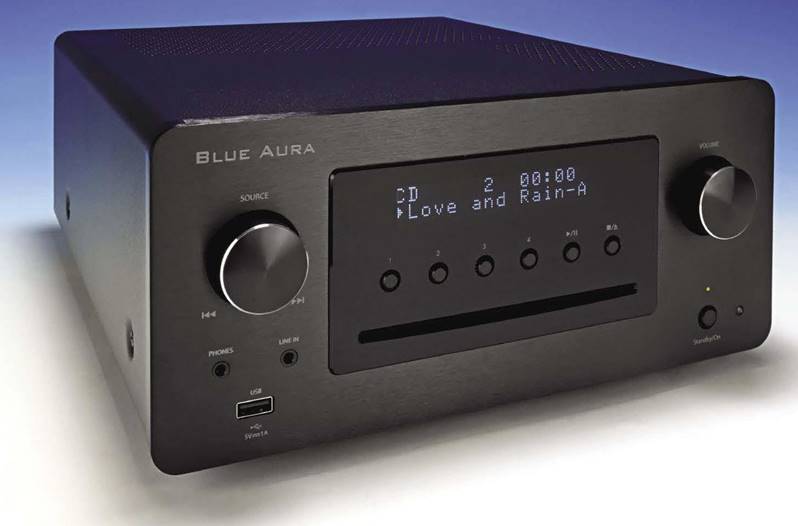BLUE AURA BLUE 1 Review: Out Of The Blue
Suddenly a receiver with VHF/FM radio, DAB and much else arrives from Blue Aura. Noel Keywood tunes in. Read our BLUE AURA BLUE 1 Review.
Receivers with gloriously illuminated tuning scales – Rotel did some beauties – left us long ago. Or so I thought, until Blue Aura’s Blue I arrived for review. We all have to be disappointed there is no tuning scale nor a giant tuning knob to go with it, but it does have VHF/FM radio for all those who are happy to surf the air waves, using mod- ern-fangled buttons and pre-sets. It has so much more though, as I’ll explain, in a compact package that costs – wait for it – just £.
You may suspect straight away there must be some serious compromises but no, there were not. It may not set the world alight in some areas, but it was beyond my expectations. The amplifier for example delivers a firm 77W, measuring superbly (see Measured Performance). No sign of crossover distortion nor anything like it, something budget amps suffer from.
This one was as dean as a whistle.
Although the presence of VHF/FM radio suggests Blue Aura have targeted oldies looking for something that will magically revive the Home Service, that’s not so. If it was so, then there would be a Phono stage for LP replay – but there isn’t. Where a simple MM phono stage has these days become almost obligatory as vinyl sales continue upward, there’s no such option here. Instead vinylistas must plug an external phono preamp into the Aux I analogue input.
Moving forwards in time from analogue radio brings us to Digital Audio Broadcasting, that wonder of the modern age that never quite made it, in spite of the European Broadcasting Union’s best efforts. All the same, for those far from Wrotham, Holme Moss, North Hessary Tor and such wind swept hills there may be a short range DAB transmitter dose by that does the job, in which case the Blue I is able to receive its signals in DAB or DAB+ form.
Another step forward in time brings us to Bluetooth (v5), also a radio transmission system and available in Blue I. Often seen as a digital input and derided for having a compression system, in recent form it gives hi-res sound quality, but you don’t quite get that here – as I’ll explain in Sound Quality.
Leaving air waves behind, the Blue I has plenty of other digital inputs. Receivers of the past did not come with record players (let’s not talk radiograms) but this one gets a disc spinner – a slot loading CD player. There are also optical and electrical S/PDIF inputs, plus a front panel mounted USB drive socket that will read a Flash (memory) drive (in Sony parlance, a Memory Stick); I presume it will also power and read a mechanical disc drive.
Reading files from a Flash drive (as I’ll call it) is one of my favourite ways of playing music: a CD player without CDs in effect. And – better – there is the potential to play hires files, including DSD – but not here.The Blue I plays CD and MP3 files, meaning wav or compressed wav, up to 24/48 I found, but not higher sample rates, losslessly compressed FLAC files, nor DSD. That’ll suit most people perhaps, if not audiophiles. Another limitation is a simple dot-matrix display with track and title but no more. However, the rear digital inputs can accept hi-res PCM (from a portable player for example), it’s only the front USB input that cannot.
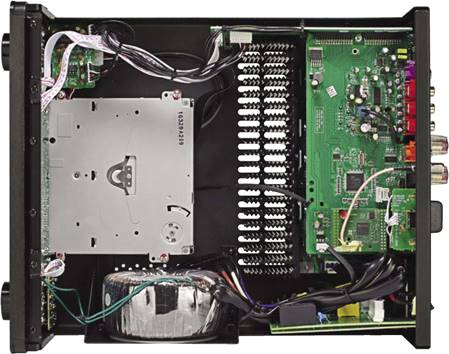
Signs of audiophile dedication: at bottom in our picture sits the alloy foil clad toroidal mains transformer of a linear power supply – likely why Blue 1 had plentiful bass. At right (rear) sits a circuit board featuring large scale integrated circuits.
What this receiver specifically lacks is USB computer connection or network connection by any method, so no app or ability to stream internet radio.
I found the Blue I easy to use. Its remote control does most of the work, as you’d expect. It switches on and off from standby – always handy – and there’s auto-standby to save power.The VHF/FM tuner will auto-tune but it is upset by noise; there’s no noise muting.Tuners like this are best set to station frequency manually: for example I found that in NW London the wire aerial supplied got best signal from Crystal Palace at 88.8MHz, rather than Wrotham (89.1MHz) that my now-deceased outdoor array once pointed at (see Radiodns.uk for this info). I used a loft aerial for radio listening. There were some confusions: the handbook says a ST beacon should light when receiving stereo but this did not work with our unit, even when receiving a powerful stereo signal from an FM test generator. Switching from Stereo to Mono when working from the aerial confirmed it was receiving stereo, just not indicating it. The aerial socket is an F connector designed to accept solid-core co-axial cable with a simple clamp; an adaptor is needed to accept co-axial (BellingLee) plugs.With 40 presets it’s best to select a preset rather than manually tune.And the wire aerial supplied is proportioned for DAB, not VHF/FM; a slightly bigger aerial is needed for best reception of the latter. Because DAB is easily blocked by buildings and hills it most needs an aerial so this is the best choice, but it is not explained anywhere. Always best to use a multi-element aerial though, preferably in the loft (i.e. high up), pointed at the local transmitter, especially with VHF/FM for hiss free reception.

Every button on the large remote control is linked to a function on the receiver; there are no redundant functions. Beneath the circular jog control lies Tone, to select bass and treble adjustment. At left lies a tuning rocker, and right a volume rocker. The unit can be switched on/off by remote too. It goes into standby after a period of inactivity.
Also available from the remote control are very well crafted tone controls, bass and treble having different characteristics – something I have not seen before (see Measured Performance). There’s a Loudness function too.
A 3.5mm stereo headphone sits on the front panel, but as you might expect connection is by wire only, not Bluetooth transmission. Pressing the BT button on the remote brought up ‘Blue I’ on my iPhone and it connected immediately via Bluetooth.
SOUND QUALITY
I connected Blue I to our resident Martin Logan ESL-X hybrid electrostatic loudspeakers through Chord Company cables. Having used it during test with Oppo PMI magnetic planar headphones
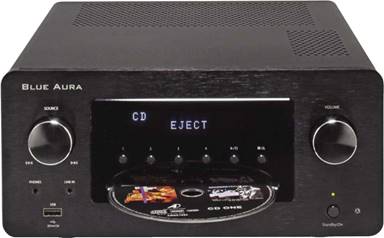
At front a slot-loading CD drive with transport buttons. Below lies a USB socket able to read music files on a Flash drive, up to 24/48 hi-res, CD, MP3 and WMA, but not FLAC.
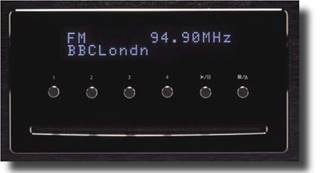
The blue dot-matrix display gives basic information only, but is visible at a distance. Forty presets can store station frequency, for instant selection.
I knew it had punchy, clean bass and that was very clearly repeated when spinning Safri Duo’s Samb Adagio on CD. Small units like this commonly come across as bass light, but not the Blue I; I carefully checked to ensure the bass control was set to zero. Running through a wide range of CDs it became dear the amplifier has quite a smooth yet dense sound with generous timbral resolution, something that worked well for classical, bringing a natural sound to Nigel Kennedy’s Stradivarius when playing Massenet’s Meditation (CD).
“the amplifier has a smooth yet dense sound with generous timbral resolution, something that worked well for classical”
Connected to an Astell&Kern AK120 portable player via a digital optical cable again there was smooth deep sound from Rebecca Pidgeon singing Spanish Harlem (24/176.4) and even Otis Redding came through in stable form, from a 24/192kHz file (optical sometimes gets shaky at this high sample rate). Playing from a Flash drive gave exactly the same sound as CD in effect, and Bluetooth worked nicely, if losing fine detail from Handel’s Lascio ch’io Planga where Johannette Zomer was firm and dear centre stage but the delicate background harpsichord got a bit lost.Yet with scuzzy Rock such as The Eagles Busy Being Fabulous that, being compressed upward to sound loud, can sound edgy, the receiver’s smooth sound balance with strong bass made sense of it.
With VHF/FM in Stereo mode noise level measured -60dB where -65dB or better is common. In practice I could not get noise free stereo from my loft aerial, but pressing the Mono button eliminated the problem entirely. It has a slightly noisy stereo decoder, but then a better aerial than mine may be the cure. DAB provided a quieter alternative to Radio 2 for example, if the harder, more mechanical sound DAB is known for. Good to hear BBC’s Maida Vale studio being rummaged through when I was sitting just around the corner; radio comes up with surprises, in this case I was listening to Radio 2 and learned that Hendrix and The Beatles played there (should’ve known that!).
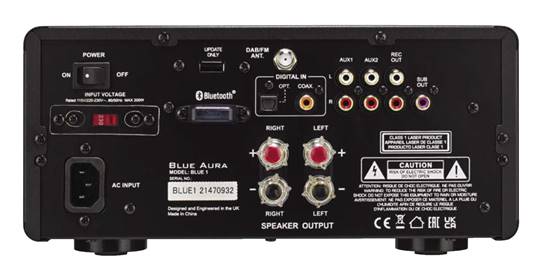
A master power switch at top left. At top centre an F connector for VHF/FM I DAB aerial. The wire aerial supplied is optimised for DAB. As always, a loft or external aerial is needed for best results.
CONCLUSION
Blue Aura’s Blue I receiver was for me a total success. From the off it was easy to understand and use (good instruction manual), having all necessary basics whilst dispensing with fripperies.There are some limitations, inability to play hi-res from a Flash drive being the most obvious, but this is possible from an external player such as the AK120 I used. With fine sound quality from the basic amplifier and a wide range of inputs, plus DAB and VHF/FM radio, it caters for most people’s needs – at a price that is breath- takingly low. Superb. I found it thoroughly enjoyable.
MEASURED PERFORMANCE
The Blue Aura Blue 1 receiver produced 66 Watts into 8 Ohms, increasing to 100 Watts into 4 Ohms. Most loudspeakers are now 6 Ohms, into which output is 77 Watts – making this a typical real- life value. It’s more than enough to go very loud, even with small (insensitive) bookshelf loudspeakers.
Output impedance was low at 0.15 ohm giving a damping factor of 54, which will impose good ‘speaker cone control.
Frequency response measured flat from 1Hz to 100kHz (-1dB) via the Aux1 input, unaffected by load value or volume control position. The tone controls were interesting and obviously carefully tailored. Bass added or subtracted output around 100Hz, putting in a peak or a dip at that frequency. Very low bass remained unaffected, to prevent excessive cone movement (and power draw). The treble control was different: it applied shelf boost or cut, in 2dB steps. There was no supersonic peaking here either. Shelf cut like this is perfect for adjusting tweeter output, mostly to tame brightness.
Distortion values were very low, measuring 0.004% up to near full output (1kHz). At 10kHz the figures changed little, just 0.01% at 1W into 4 Ohms as our analysis shows. At full output this rose to just 0.02% – so no crossover distortion.
The optical digital input worked up to 192kHz sample rate (as did the electrical), the digital S/PDIF inputs giving a respectable 109dB EIAJ Dynamic Range value (better than CD). Frequency response extended to 53kHz before falling away to 96kHz, the theoretical maximum. Distortion was a low 0.1% (24bit, -60dB) and 0.22% with CD as always due to 16bit quantisation noise.
Bluetooth frequency response was flat to 20kHz and Dynamic Range 90dB, 10dB worse than CD but as expected for a budget system.
The VHF/FM section measured flat to 6kHz, with just slight roll down to -1dB at 12kHz before the pilot tone filter notch at 19kHz. Full quieting (minimum hiss) was fair at -60dB, reached >200 muyV aerial input, making sensitivity good.
The Blue 1 gave either superb or very good results in all areas.
Power (8 ohm) 100W
Frequency response 1Hz-100kHz
Distortion (10kHz, 1W, 4 ohm) 0.01% Noise (IEC A) -98dB
Sensitivity 400mV
DIGITAL
Frequency response 10Hz-53kHz Distortion (-60dB, 24bit) 0.1%
Dynamic Range (EIAJ) 109dB
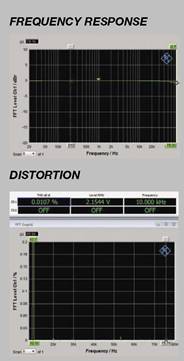
OUTSTANDING – amongst the best.
VALUE – keenly priced.
VERDICT
When you purchase through links on our site, I may earn an affiliate commission. Here’s how it works.
Blue Aura
+44 (0)1480 477738
www.blueaura.co.uk
